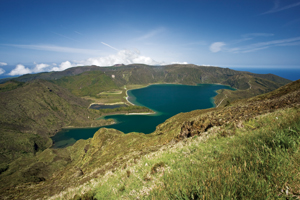The Azores
Unspoilt golfing desitnations with great climates and inspiring vistas are truly hard to come by, so Rob Smith delights in unearthing the Azores


The Algarve? Lovely. The Costas? Yes. Florida? Been there, got the embossed polo shirt. The Caribbean? Superb courses but what a distance, and sometimes just too hot! Many people, myself included, are getting a little tired of the formulaic, housing-estate developments that typify the cutting edge of modern golf-course architecture. Just how many more American-style, par-72, waste-bunkered championship courses with innumerable water hazards do we need? In addition, we hanker after destinations that offer something different away from the golf, preferably with scenery that is both beautiful and unspoilt. Do such places exist and, if so, are they easily accessible?
Fear not, for appearing on the golfing radar is a collection of Atlantic islands, just under 1,000 miles to the west of Portugal, and a mere three-and-a-half-hours by air from the UK. The Azores is a chain of nine beautiful islands which, despite popular misconception, do not include Madeira. The name Azores comes from the plural of the Portuguese word for blue, though you are unlikely to feel the blues if you are lucky enough to be heading for Sao Miguel. This lush and scenic island is the largest and most heavily populated and is home to two golf clubs, Batalha and Furnas, both of which are undergoing a steady but subtle programme of improvement under the excellent stewardship of Troon Golf.
Batalha
Batalha Golf Club is 12 years old and boasts three distinct loops of nine holes built on volcanic rock with some superb views down to the coastal villages and the Atlantic beyond. It seems far more mature and established than its age would suggest, and a sign of the quality of the golf is that earlier this year it hosted the Azores Senior Open, on the European Seniors Tour. The three loops, which vary considerably in nature, were designed by Bob Cameron and Chris Powell. They are currently, rather inspirationally, called A , B and C , but thankfully there are plans for a re-christening.
The A loop contains some of the prettiest and best holes. The 1st is an attractive shoulder-opener of a par 5 with water to be negotiated, whilst the 4th is an exceptionally long dog-leg back up the hill a full 611 yards off the back tee. Not to worry, however, as for us mortals it s a mere 586 yards off the yellow tees! The toughest hole and probably the best of the 27 is the 6th, a never-ending par 4 that runs down into a valley and up the other side. It s one of those holes where it takes three good shots to get up.
The B loop is tighter and hillier, climbing gently up to the 14th tee, where there are genuinely breathtaking views. The 15th is an excellent par 3 from an elevated tee, and while not too many courses finish with a short hole, this one does with a 208-yarder that plays every inch of its length. The clubhouse is above and to the left, and one of my playing companions pulled a long-iron onto the patio, where the ball took one huge leap upwards and crashed into the window of the club s main office whoops!
The final group of holes is also great fun, but very hilly so a buggy is a good idea. It also contains a couple of tricky back-to-back par 4s at 7 and 8 where the dog-legs are so severe and angular that positioning the tee shot is extremely difficult.
Subscribe to the Golf Monthly newsletter to stay up to date with all the latest tour news, equipment news, reviews, head-to-heads and buyer’s guides from our team of experienced experts.
Furnas
Furnas Golf Club was constructed as a nine-holer by Scottish architect Mackenzie Ross in 1939. Originally the private playground of a multi-millionaire, it was extended in the 80s to 18 holes with a par of 72 again by Cameron and Powell. However, despite similar parentage, the course is completely different in nature to Batalha with fewer panoramic views, but a beautiful and unspoilt inland location with easy walking, majestic Japanese cedars, and small greens in first-class condition.
While holes 1 to 4 and 14 to 18 are clearly the original nine, the newer holes have been designed sympathetically to create an overall excellence. Of the newer holes, the only real weakness is the blind tee shot on the 5th, when you just don t know where to aim. Happily, there are plans to rectify this, and 6 and 7 both tempt the golfer to try and cut off as much of the dog-leg to the right as possible. There is also visual compensation in the attractive water features at this far-flung point of the course, and from the 8th onwards, itself a very pretty short hole, it is quality golf all the way. The highlight is probably the superb long par-4 17th 464 yards with a pond to the left of the green and a severe dip in front. Only a perfectly struck approach will find the green and stay there. All in all, a great contrast and companion to Batalha.
Off-course action
For those wanting a golf holiday that is not just a golf holiday, there is plenty on offer that is unique to the Azores. Way back in the mists of time there were three active volcanoes in these parts. Following the kind of eruptions that you would normally only see when following Monty around the course, the deposits merged to form Sao Miguel. It is now a kind of mini-Hawaii, with an abundance of verdant pasture and forest-covered peaks. The craters themselves are filled with water and are stunningly attractive; the ultimate infinity pools. Another legacy of the geology is the hot springs and geysers that provide therapeutic waters, where the only downside is the pungent odour of sulphur. Up in the hills, we were taken to a beautiful waterfall where we bathed under the tumbling water.
Head out to see whales, dolphins and turtles from the host of the small harbours and ports that line the coast. We were lucky enough to find a group of three sperm whales a mile or two out into the Atlantic a truly awe-inspiring encounter.
Fine dining
There are plenty of hotels to suit all tastes and wallets. They are generally quiet and unassuming in appearance and nature as well as friendly and efficient. As you would expect, a speciality is the excellent and wide variety of modestly priced and locally caught fish. However, the island s gastronomic claim to fame comes courtesy of the geysers where entire meals are cooked in small wells just below the surface. If you visit the northern part of the Furnas Lake late in the morning, you can see the local restaurants collecting huge casserole dishes. All ingredients are stacked in the same container beef, pork, chicken, veal and all kinds of vegetables and the results are unusual but very tasty. Indeed, despite being something of a fusspot, I enjoyed several things that I could not even identify.
Azores essentials
Despite being in the middle of the Atlantic, the climate here is ideal for golf. Never too hot in the summer (mid-20s), it is seldom if ever below about 15ºC in the winter. Most people expect it to be very windy, but this was not a feature on my visit in June. Naturally for somewhere so green and lush, there is rain, but this tends to be between October and April and is usually followed by sunshine one of those four-seasons-in-one-day places.
Sao Miguel s main exports include coffee, tea, pineapple, tobacco, bananas and pepper; the ingredients for a nightmare edition of Celebrity Master Chef! The road system throughout is impressive, not only in terms of good surfaces but also due to the wonderful vistas on offer and ease of access to all corners of Sao Miguel. The island is liberally sprinkled with small, friendly and unspoilt villages, most of which offer a restaurant and bar or two, and English is widely spoken. At present, the only other golf on offer in the Azores is on Terceira, but Nick Faldo is currently involved in the construction of a new course on Santa Maria, Sao Miguel s nearest neighbour.
Many golfing destinations are let down by one of two things. One is that the golf is good but there is nothing else to do; the other is that the location is great but the golf does not live up to it. Sao Miguel is an exception. It may be something of a golfing cliché, but the best way to describe it would be as an undiscovered gem. My advice to any well-worn travelling golfer is very simple. Go to the Azores soon but don t tell anyone else about it.
CONTACTS BOOK
Getting there
SATA fly from Gatwick & Manchester
W: www.sata.pt
Play
Batalha
W: www.portugal-golf.info/azores/batalha
Stats: A par 36, 3,616 yards
B par 36, 3.420 yards
C par 36, 3,507 yards
Furnas
W: www.portugal-golf.info/azores/furnas
Stats: par 72, 6,815 yards
Stay
Caloura Hotel
W: www.calourahotel.com
Off Course
General info
W: www.azoresgolfislands.com
W: www.visitazores.org
Whale watching
W: www.seawatch.com.pt

Rob has been playing golf for over 45 years and been a contributing editor for Golf Monthly since 2012. He specialises in course reviews and travel, and has played over 1,250 courses in almost 50 countries. In 2021, he played all 21 courses in East Lothian in 13 days. Last year, his tally was 78, exactly half of them for the first time. One of Rob's primary roles is helping to prepare the Top 100 Courses of the UK&I, of which he has played all, as well as the Next 100 where he is missing two in Scotland and two in Ireland. He has been a member of Tandridge for over 30 years where his handicap hovers around 15. You can contact him at r.smith896@btinternet.com.